Besides shaving or not shaving your dog in the summer, another controversial dog topic in the big dog community is whether to feed your dog from elevated dog bowls or not.
It used to be thought that feeding a dog from a raised bowl was an important step in preventing dog bloat.
However, in recent years some people have come to the conclusion that using an elevated dog feeder might actually lead to dog bloat/GDV.
I personally have always fed my big dogs from slightly raised dog bowls but I wanted to see what other big dog owner’s so I asked around.
I recently took a poll on 3 of our social media channels to ask what our peers in the giant breed dog world do and the results were pretty surprising!
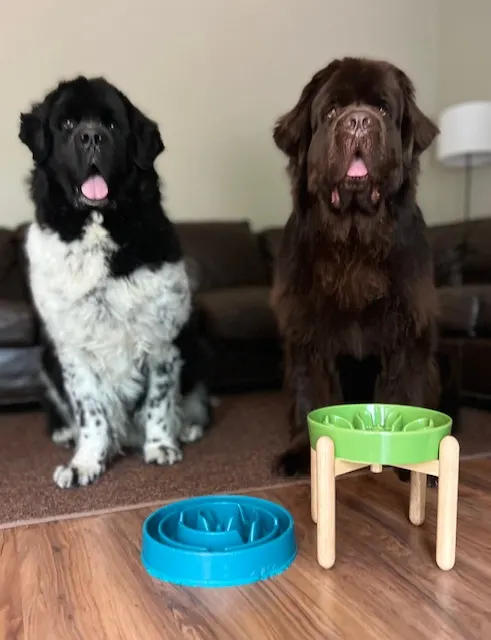
With just under 400 large breed dog owners chiming in on Facebook, Instagram and TikTok, the number of people that fed their dogs from some type of elevated dog dish definitely outweighed those that fed their dogs their meals at ground level.
Some people said that they also use a raised water bowl and many dog owners stated that they use raised dog feeders due to the benefits they see, especially when it comes to senior dogs or big dog breeds.
It’s a confusing topic that has many conflicting statements behind it and some that I’ve debated with my dogs in mind.
From all the comments that I’ve gone through, it seems like many of those that have been feeding their dogs from raised bowls for several years have stayed the course.
There was also an equal amount of people who said that one of their dogs experienced bloat and was fed from an elevated dog bowl and those that had bloat that were fed at ground level.
I’ve always had an elevated feeding station with my Newfies, except for Lou so that’s why this topic is of specific interest to me.
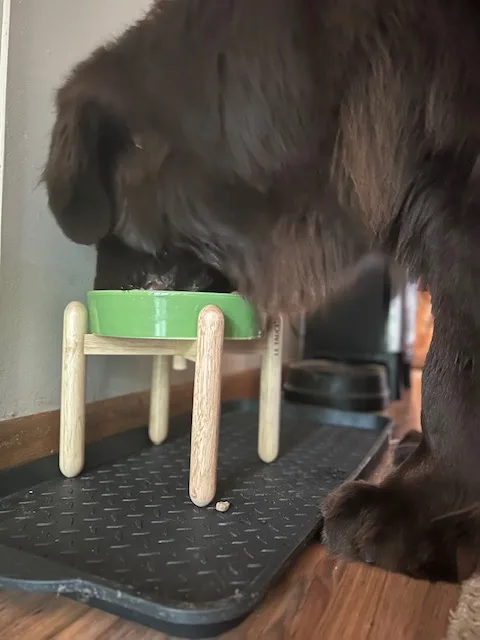
The Raised Dog Bowl Confusion
When I got my first Newfie, it was a no-brainer to use a raised dog food bowl because that’s what the original Purdue Bloat Study concluded.
All of that changed in 2004 when Purdue University published the Glickman Study findings.
Those findings caught almost every big dog owner off guard.
Contrary to what we previously believed about many of the causes of dog bloat, the new study suggested otherwise including one big one = feeding dogs from raised feeders increased their risk of developing bloat instead of decreasing it.
This finding was also combined with other things that we already knew increased the risk of bloat such as age, genetics, size of chest, weight, behavior, and diet.
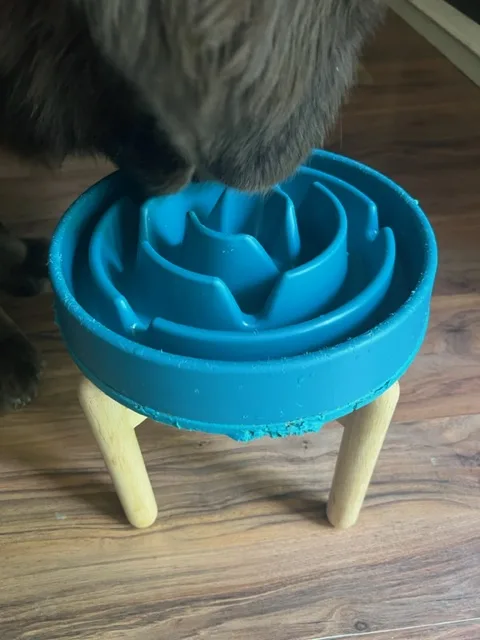
Confusing Results of the Glikman Study
If you want to read the Glikman Study for yourself, you can check that out HERE.
Basically, Dr. Larry Glickman, an epidemiologist at the Purdue University School of Veterinary Medicine, conducted a controlled study on canine bloat, beginning in 1994.
He followed 1,914 dogs who did not have a prior history of bloat.
Eleven large and giant breeds were represented in the study.
Some risk factors identified were:
- Deep chests. breeds with deep and narrow chests were more at risk for developing bloat which we already knew from the Purdue Study.
- Lean dogs were found to be more at risk than obese dogs.
- Risks of developing bloat increase with age. For large breeds, the risk of developing bloat goes up 20 percent each year after the age of 5. For giant breeds, it goes up 20 percent each year after the age of 3.
- Genetics. First-degree relatives of dogs that have had bloat have a 63 percent greater risk of developing bloat themselves.
- Fast eating. Dogs that eat quickly have a 15 percent higher risk of developing bloat. This may be related to increased swallowing of air.
- Fearful, nervous or aggressive dogs are more at risk for bloat. Stress can also be a factor since many dogs have bloated after recently being boarded or recent long car rides.
- Elevated dog food and water bowls showed an increased risk of developing bloat by 110 percent.
What’s even more interesting is that many of the old theories that we believed were not mentioned at all in the study such as:
- Increased risk of bloat to exercise before or after eating. Most dogs in the Glickman study bloated in the middle of the night with an empty, gas-filled stomach.
- No correlation between an increased risk of bloat and vaccines.
- No increased risk of GDV based on dog food brands
- No correlation between bloat and the amount of water consumed before and after eating
“The cumulative incidence of GDV during the study was 6% for large-breed and giant-breed dogs. Factors significantly associated with an increased risk of GDV were increasing age, having a first-degree relative with a history of GDV, having a faster speed of eating, and having a raised feeding bowl. Approximately 20 and 52% of cases of GDV among the large breed and giant breed dogs, respectively, were attributed to having a raised feed bowl.”
I personally view those results as meaning large dog breeds prone to bloat that eat fast from a raised bowl are at an increased risk for developing bloat but I would also love to know how many inches off the ground those raised dog bowls were.
Were they at eye level or just a few inches off the ground?
But that’s me.
There are also dog owners that felt that the Glickman Study provided enough evidence for many of them to switch from a raised dog bowl to a bowl that sits on the ground.
The rest of us continued with what we’ve been doing for 20+ years.
For me, that means I’ve stuck with what has worked over the years with my Newfoundlands and eating from elevated food bowls but let’s take a look at some pros and cons of using them in case you’re on the fence.
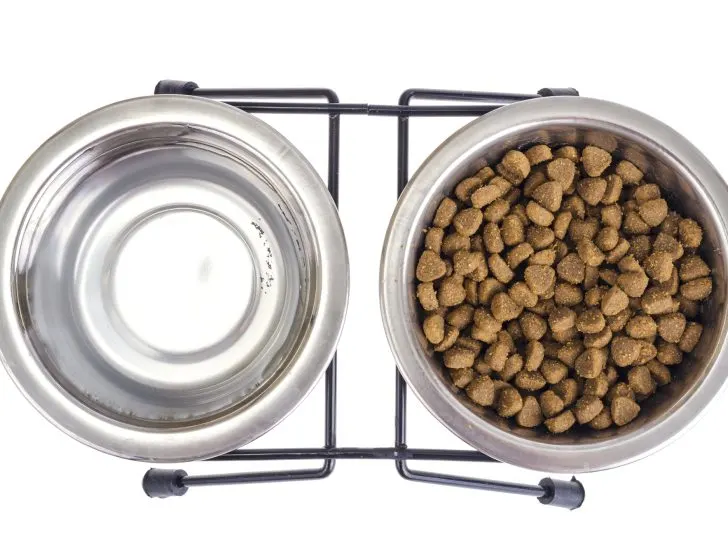
The Benefits Of Elevated Dog Bowls
Other than trying to prevent bloat, most dog owners use an elevated bowl due to comfort
Newfies have big heavy heads and strong necks so raised bowls can make it easier for them to eat or drink.
This might also help with posture and strain on the joints.
Another plus of using elevated dog bowls is cleanliness.
Especially if you have a dog that likes to dip its entire nose in the water bowl and blow bubbles.
Regardless, Newfies are messy drinkers and at least require a boot mat to catch the waterfalls.
They can also be an option for ground-fed dogs that like to flip their bowls over to eat or excited eaters that use their dog bowl as a hockey puck.
An elevated water bowl may also encourage a dog to drink slower but in my head I also see Newfies taking it as the perfect opportunity to blow bubbles in their bowl as they walk past it.
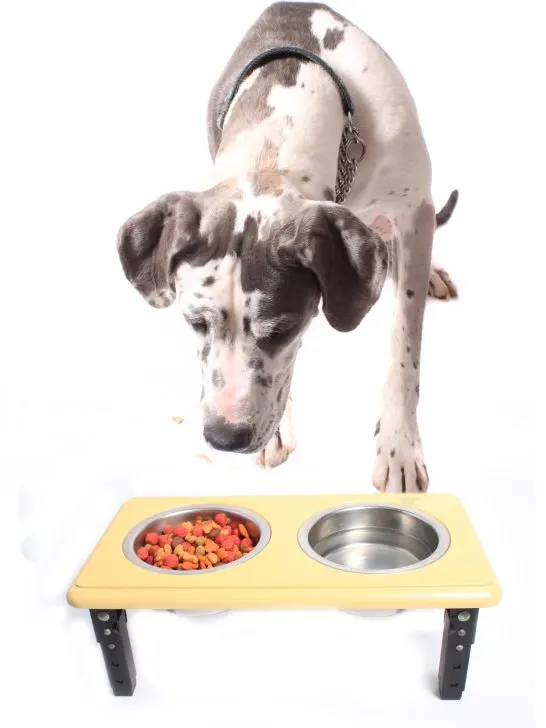
The Risks Of Raised Dog Feeders
As with anything and everything, of course, there are risks with using a raised dog feeder.
Some dogs might eat faster when being fed from an elevated dog bowl, increasing their risk for GDV
I’m currently using a slow feeder dog bowl on a stand for Lou but I also use a slow feeder on the ground for him because I’m trying to make sure he’s eating at the same speed.
It’s always important to be mindful of your dog’s eating and drinking behavior, so watch your Newfie when you feed them.
There are several ways you can help your dog eat slower!
But most dog owners that we asked said their dogs were fast eaters so instead of feeding them their meals in an elevated dog bowl, they use a puzzle feeder or snuffle mat.
There was also a handful of dogs that prefer to eat laying down.
Many dog owners also believe that dogs in the wild eat from ground level so it’s more natural for their dogs to do it.
What About Injured or Sick Dogs?
If you’re still undecided on which route to take, consider your dog’s age and health.
Newfies are prone to several medical problems such as neck and joint injuries.
Watch your Newfie when they eat.
Pay attention to their body and their eating habits.
Do they not eat out of their bowl that’s on the ground but they’ll eat out of your hand?
Do they lie down to eat?
Do they take their food out of the bowl and lay down to eat it?
What’s A Dog Owner To Do?
My take on it is that right now, that decision ultimately is up to the owner.
For me, it means that I will continue to watch my dog’s eating habits carefully and make the decision that I feel is best for them which might not be what is best for someone else’s dog.
My dogs are each individual dogs and eat differently.
Odin eats his meals from a feeding station that has 2 bowls.
He’s not a slow eater but he’s also not a fast eater.

He gets half of his dog food in 1 bowl and the other half of his food in the other bowl.
Lou is a fast eater and eats his food from a slow feeder at ground level but I recently bought him an elevated slow feeder bowl.
He doesn’t eat any faster from the raised slow feeder dog bowl than he does with the slow feeder on the ground.
Right now, he eats his bigger morning meal on the ground and his slightly smaller second meal from the raised bowl.
As always, knowing the signs of bloat and taking precautions to prevent GDV are always the most important defense.
p.s. I want to note that it’s my understanding that most people that I asked are using raised dog bowls or stands that are only raised a few inches off the ground.
Not many people are feeding from elevated dog bowls at mouth level.